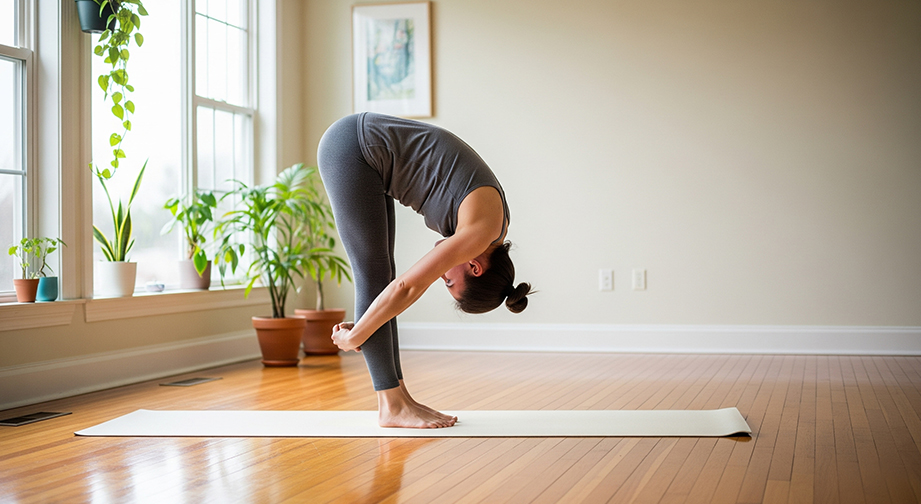Uttanasana (Standing Forward Bend): The Calming Yoga Asana for Flexibility & Peace
Introduction
Uttanasana (pronounced oot-tan-AH-sah-nuh), also known as the Standing Forward Bend, is a fundamental yoga posture where you gently fold forward from the hips, letting your upper body hang towards the ground.
In Sanskrit, "Uttana" means "intense stretch," and "asana" means "pose"—so Uttanasana is the "Intense Forward Stretch Pose."
Essence: Calming and grounding—this pose soothes the mind while offering a deep stretch to the entire back body.
If you’ve ever felt stiff after long hours at your desk or just need a quick recharge, Uttanasana can ease that tense energy and help you reconnect with your breath.
Step-by-Step Guide for Uttanasana (Standing Forward Bend)

- Start in Tadasana (Mountain Pose): Stand with your feet hip-width apart, arms relaxed by your sides; distribute your weight evenly.
- Inhale: Lengthen your spine and reach your arms overhead.
- Exhale: Hinging from your hips (not your waist), begin to fold forward, keeping your spine long, and bringing your chest towards your thighs.
- Release your hands: Let your fingertips or palms rest on the floor beside your feet. If they don’t reach, rest them on your shins or use a yoga block.
- Keep your knees soft or slightly bent (important for beginners and those with tight hamstrings).
- Let your head and neck relax, allowing your crown to point towards the ground.
- Take 5-8 slow breaths. Each time you inhale, feel your spine stretch. Each time you exhale, allow your torso to release deeper into the fold.
- To come up: With a microbend in your knees, press into your feet and, on an inhalation, slowly roll up to standing. Bring your head up last.
Recommended duration: Hold for 30–60 seconds, repeat 2–3 rounds if desired.
Modifications for Beginners:
• Bend your knees as much as you need
• Rest your hands on yoga blocks or your shins
Advancing the Pose:
• Work towards straightening the legs as flexibility improves
• Reach palms under the feet (Padahastasana) or catch behind the calves for a deeper stretch
Alignment & Safety Tips
- Alignment cues: Hinge from your hips, not your waist. Keep your weight centered over the balls of your feet and heels evenly.
- Common mistakes: Rounding your back—try to keep your spine long. Locking your knees—keep a microbend.
- Safety precautions:
- Avoid if you have recent or severe back injuries.
- Pregnant individuals should avoid deep forward bends—try a wide-legged standing fold instead, keeping the torso upright.
- If you have high blood pressure, keep your head above heart level or practice Ardha Uttanasana (Half Forward Fold) with hands on a wall or blocks.
Benefits of Uttanasana
Physical Benefits
- Stretches and lengthens the hamstrings, calves, and hips
- Relieves tension in the spine, neck, and back
- Improves posture and flexibility in the back body
- Stimulates the abdominal organs—may aid digestion
Mental Benefits
- Calms the mind and helps relieve anxiety and stress
- Encourages introspection and mindfulness
- Soothes the nervous system
Energy & Chakra Connection
- Grounds and balances the energy (root chakra - Muladhara)
- Promotes a sense of surrender and quietude
Contraindications
- Do not practice if you have a recent back injury, herniated disc, or severe hamstring strain.
- People with glaucoma or ocular pressure issues should avoid deep forward bends.
- If pregnant past the first trimester, avoid deep folds; try Ardha Uttanasana (Half Forward Fold) with hands on the wall or blocks.
Safe Alternatives: Try Ardha Uttanasana (Half Lift) or Supta Padangusthasana (Reclining Hand-to-Big-Toe pose) for gentle stretching.
Beginner’s Tips & Variations
- Props: Place blocks under your hands to bring the floor closer. Use a rolled towel behind the knees for extra support.
- Gentle Variations: Bend the knees deeper and let your belly rest on your thighs. Practice with feet hip-width or wider for more comfort.
- Advanced Variations: Straighten the legs as flexibility increases; try catching your big toes with your peace fingers (Padangusthasana) or sliding palms under your feet (Padahastasana).
How to Include Uttanasana in a Yoga Flow
- Best used as: A warm-up (to stretch the back of the legs), as a main posture in standing sequences, or as a soothing cool-down pose.
- Perfect pairs: Try Uttanasana between Adho Mukha Svanasana (Downward Facing Dog), Tadasana (Mountain Pose), and Bhujangasana (Cobra Pose) for a well-rounded practice.
Mind-Body Connection
Practicing Uttanasana is an invitation to slow down, observe your breath, and notice how your body feels in the moment. As you hang forward, imagine letting stress and tension gently melt away.
Spiritually, this pose is said to activate the Root Chakra—helping you feel more grounded, connected, and centered.
Summary Box: Uttanasana (Standing Forward Bend)
- Asana Name: Uttanasana (Standing Forward Bend)
- Sanskrit: ????????
- Level: Beginner-Friendly (with advanced options)
- Focus Areas: Hamstrings, spine, calves, hips
- Duration: 30–60 seconds (1–3 rounds)
- Best Time: Morning (energizing), Evening (relaxing)
FAQs about Uttanasana (Standing Forward Bend)
Q: Do I need to touch the floor in Uttanasana?
A: Not at all! Use blocks or rest your hands on your shins as you build flexibility.
Q: My hamstrings hurt—should I keep my knees straight?
A: It’s safer (and more effective!) to keep a generous bend in the knees, especially if you’re tight in the back of your legs.
Q: Can Uttanasana help relieve back pain?
A: For many people, this pose brings relief from mild back tension, but always move gently and avoid if you have any serious back issues.